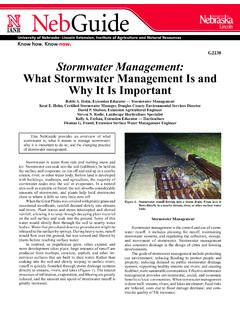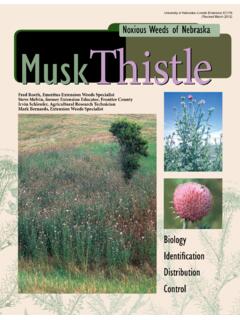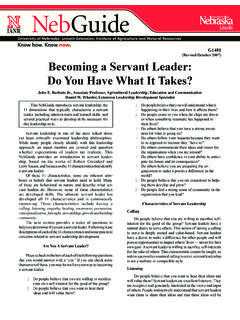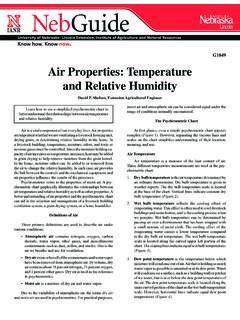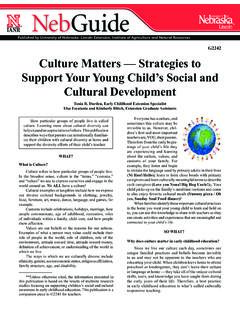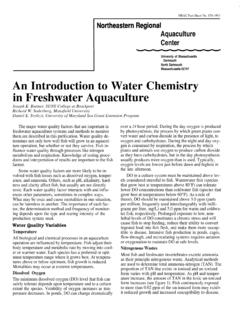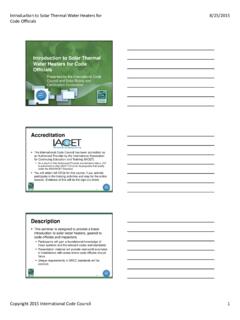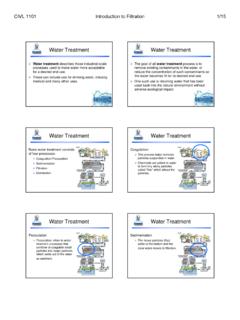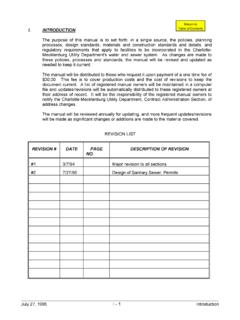Transcription of An Introduction to Drinking Water - University of …
1 Know how. Know now. University of Nebraska Lincoln Extension, Institute of Agriculture and Natural ResourcesG1539(Revised January 2011)An Introduction to Drinking WaterSharon O. Skipton, Extension Water Quality EducatorBruce I. Dvorak, Extension Environmental Engineering SpecialistWayne Woldt, Extension Water and Environment SpecialistDrinking Water quality is a common concern among people today. This publication serves as an introductory reference on Drinking Water protection, quality and Much Do You Know About Your Drinking Water ?How much do you really know about the Water you drink every day? Where does it come from? Is it safe to drink? Is a home Water treatment system necessary?
2 How can Drinking Water be protected? This publication will begin to answer those questions. In addition, it will reference more comprehensive University of Nebraska Lincoln Extension publications on each topic Is Essential to LifeWater is second to oxygen as being essential for life. People can survive days, weeks, or even longer without food, but only about four days without average adult consumes and excretes 2 or more quarts of Water each day. Some of this Water is supplied through foods but most is consumed through beverages. It is generally recommended that adults consume 6 to 8 cups (48 to 64 ounces) of liquids daily. Some beverages, such as coffee, tea, soda with caffeine, and alcohol are diuretic and increase urine excretion.
3 These beverages, if consumed in large quantities, can upset the body Water balance. For more information, see NebGuide G918, Water : The s In Your Water and What Does It Mean To Your Health? Drinking Water is never pure. Water naturally contains minerals and microorganisms from the rocks, soil, and air with which it comes in contact. Human activities can add many more substances to Water . But Drinking Water does not need to be pure to be safe. In fact, some dissolved minerals in Water can be beneficial to health. For example, the National Research Council (National Academy of Sciences) states that Drinking Water containing dissolved calcium and magnesium generally contributes a small amount toward calcium and magnesium human dietary needs.
4 Fluoride, either naturally occurring or added to the Water supply, can help protect against tooth decay. Whether or not Drinking Water is safe will depend on which substances are present and in what amounts. For additional information, see NebGuide G907, Drinking Water : Testing for Safe is Our Public and Private Drinking Water In Nebraska?Public Drinking Water SafetyIn 1974, the Congress enacted a program to ensure that our public Drinking Water is safe. The Safe Drinking Water Act directs the Environmental Protection Agency (EPA) to establish minimum national Drinking Water standards. Regulations set achievable levels of Drinking Water quality to protect health. These standards set limits on the amounts of various substances allowed in public Drinking Water .
5 This means that every public Water supply in the country serving at least 15 service connections or at least 25 people must ensure that its Water meets these minimum standards. Even noncommunity supplies such as campgrounds and roadside motels with their own Water supplies are covered by the regulations. Drinking Water regulations established by EPA reflect the best available scientific and technical judgment. The Nebraska Department of Health and Human Services (DHHS) is the primary agency responsible for enforcing the federal Drinking Water regulations in standards for public Drinking Water fall into different categories. Primary Standards and Action Levels are based on health considerations and are designed to protect people from three classes of pollutants: pathogens (disease-causing microbes), radioactive elements, and toxic chemicals.
6 Primary Standards and Action Levels are enforceable. Secondary Standards are based on taste, odor, color, corrosivity, foam-ing, and staining properties of Water . Secondary Standards are not enforceable but serve as guidelines for Water utili-ties attempting to provide the best quality Water possible. Health Advisories are an estimate of acceptable Drinking Water levels for a chemical substance over a given period of time based on health effects information. Health Advisories are not enforceable, but serve as technical guidance. EPA regulations currently cover about 100 potential contaminants. The number of contaminants regulated is being increased, and standards are re-evaluated as new data and information become Drinking Water standards involves uncertainty.
7 Data relating human health effects to chemicals in Drinking Water are limited, and scientists have difficulty predicting the effects of Drinking small amounts of chemicals in varying combinations over a lifetime. In addition, regulatory deci-sions frequently incorporate economic, political, and social considerations. Therefore, it is important to understand that standards for Drinking Water contaminants do not guarantee that Water with a contaminant level below the standard is risk-free. Nor do the regulations mean that Water with a higher level is automatically unsafe. Current Drinking wa-ter standards reflect scientific judgment based on the best available public Water suppliers must supply Water that is tested.
8 There are specific requirements for the frequency of testing for each contaminant. Requirements vary generally larger systems and systems serving permanent resident populations are required to have more testing done. If a contaminant is found to be above the maximum level allowed, the Water supplier must reduce the level. Some options available in-clude dilution with another Water source, Water treatment, or obtaining an alternate Water source. Problem-solving when Water has a contaminant above the maximum level allowed is often difficult and expensive. Therefore, protection of the current Water sources from contamination is the best alternative and a high priority for public Water suppliers must notify consumers if a Drinking Water standard is violated.
9 The announcement will explain the problem and its potential adverse health effects. It also will explain what precautions should be taken by consum-ers and what the supplier is doing to correct the problem. The problem may be at the Water source, in the distribution system, or be the result of faulty testing Drinking Water SafetyWhile the DHHS regulates private Drinking Water well construction and location, it does not regulate the safety or quality of Water provided by private wells. In addition, the Safe Drinking Water Act does not apply to private Drinking Water supplies. Thus, the safety and quality of private drink-ing Water in Nebraska is not subject to any federal or state regulation, and is at the discretion of the Water user except in cases where Water quality is regulated at the local level or when state licensing may be required for a specific activity.
10 Lending agencies may require a private Water supply meet Safe Drinking Water Act nitrate and bacteria standards prior to approving a real estate loan. In most cases, the well also must meet current DHHS construction and location standards before a loan is not required by federal or state regulations, testing a private Water supply may be justified. Since there are many potential Water contaminants, it would be very costly and in most cases unnecessary to test for them all. Tests for nitrate and bacteria often are used as general indicators of the safety of private well Water , and generally, private Water supplies should be checked annually for these contaminants. Testing for nitrate and bacterial contamination should be considered after flooding or when any noticeable change in taste, color, or smell of the Water is detected.
